Pura Kehen |
|||||||||||||||||||||||||||||||||||||||||||||||||||||||||||||||||||||||||||||||||||||||||||||||||||||||||||||||||||||||||||||||||||||||||||||||||||||||||||||||||||||||||||||||||||||||||||||||||||||||||||||||||||||||||||||||||||||||||||||||||||||||||||||||||||||||||||||||||||||||||||||||||||||||||||||||||||||||||||||||||||||||||||||||||||||||||||||||||||||||||||||||||||||||||||||||||||||||||||||||||||||||||||||||||||||||||||||||||||||||||||||||||||||||||||||||||||||||||||||||||||||||||||||||||||
|
|
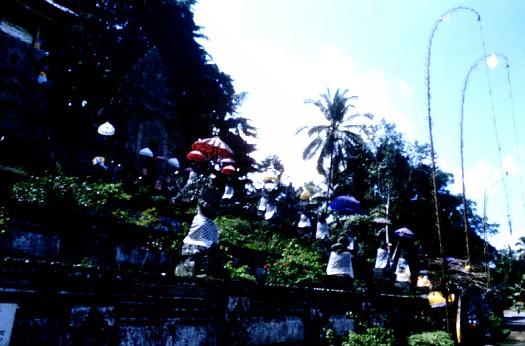 Weaving was all very nice, but we told Dewa we wanted to see temples!
He brought us to the village of Bangli, where we stopped to see the amazing
temple of Pura Kehen, one of the most important temples in all of Bali.
It looked like there had been a big temple festival the day before - the
whole temple was decorated with flags and umbrellas, and those tall poles
called penjor made of bamboo, with palm decorations, that we'd
seen our very first day in Bali.
Weaving was all very nice, but we told Dewa we wanted to see temples!
He brought us to the village of Bangli, where we stopped to see the amazing
temple of Pura Kehen, one of the most important temples in all of Bali.
It looked like there had been a big temple festival the day before - the
whole temple was decorated with flags and umbrellas, and those tall poles
called penjor made of bamboo, with palm decorations, that we'd
seen our very first day in Bali. |
||||||||||||||||||||||||||||||||||||||||||||||||||||||||||||||||||||||||||||||||||||||||||||||||||||||||||||||||||||||||||||||||||||||||||||||||||||||||||||||||||||||||||||||||||||||||||||||||||||||||||||||||||||||||||||||||||||||||||||||||||||||||||||||||||||||||||||||||||||||||||||||||||||||||||||||||||||||||||||||||||||||||||||||||||||||||||||||||||||||||||||||||||||||||||||||||||||||||||||||||||||||||
|
|
 At the top of the steps we found ourselves in a large courtyard, surrounded
by temple buildings, some thatched with coconut thatch, others tiled.
At the top of the steps we found ourselves in a large courtyard, surrounded
by temple buildings, some thatched with coconut thatch, others tiled. |
||||||||||||||||||||||||||||||||||||||||||||||||||||||||||||||||||||||||||||||||||||||||||||||||||||||||||||||||||||||||||||||||||||||||||||||||||||||||||||||||||||||||||||||||||||||||||||||||||||||||||||||||||||||||||||||||||||||||||||||||||||||||||||||||||||||||||||||||||||||||||||||||||||||||||||||||||||||||||||||||||||||||||||||||||||||||||||||||||||||||||||||||||||||||||||||||||||||||||||||||||||||||
|
|
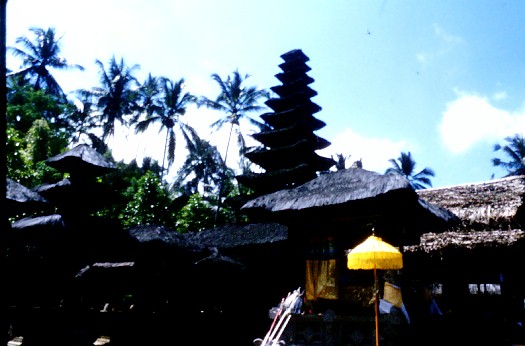 A tall pagoda-like structure - a meru - towered over the whole temple.
The more levels on the meru, the more important the temple.
A tall pagoda-like structure - a meru - towered over the whole temple.
The more levels on the meru, the more important the temple.
|
||||||||||||||||||||||||||||||||||||||||||||||||||||||||||||||||||||||||||||||||||||||||||||||||||||||||||||||||||||||||||||||||||||||||||||||||||||||||||||||||||||||||||||||||||||||||||||||||||||||||||||||||||||||||||||||||||||||||||||||||||||||||||||||||||||||||||||||||||||||||||||||||||||||||||||||||||||||||||||||||||||||||||||||||||||||||||||||||||||||||||||||||||||||||||||||||||||||||||||||||||||||||
|
|
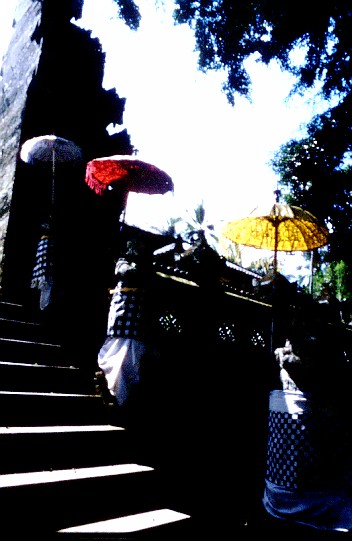 Each of the ancient statues that lined the steps had been given a sarong
and checkered apron, and an umbrella to shade it from the sun. The checkered
cloth is seen all over Bali, and symbolizes the duality of nature - male/female,
dark/light, good/evil...
Each of the ancient statues that lined the steps had been given a sarong
and checkered apron, and an umbrella to shade it from the sun. The checkered
cloth is seen all over Bali, and symbolizes the duality of nature - male/female,
dark/light, good/evil... |
||||||||||||||||||||||||||||||||||||||||||||||||||||||||||||||||||||||||||||||||||||||||||||||||||||||||||||||||||||||||||||||||||||||||||||||||||||||||||||||||||||||||||||||||||||||||||||||||||||||||||||||||||||||||||||||||||||||||||||||||||||||||||||||||||||||||||||||||||||||||||||||||||||||||||||||||||||||||||||||||||||||||||||||||||||||||||||||||||||||||||||||||||||||||||||||||||||||||||||||||||||||||
|
|
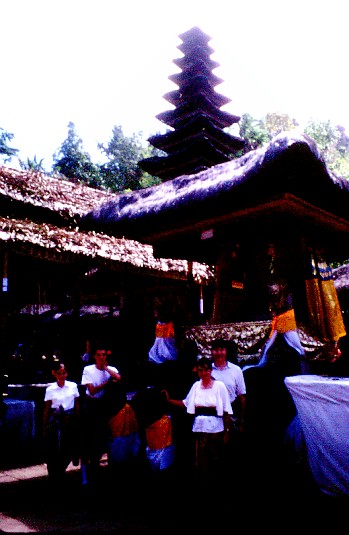 Here's our family - Julia, Dan, Astrid and myself, in front of one of the
shrines.
Here's our family - Julia, Dan, Astrid and myself, in front of one of the
shrines.
|
||||||||||||||||||||||||||||||||||||||||||||||||||||||||||||||||||||||||||||||||||||||||||||||||||||||||||||||||||||||||||||||||||||||||||||||||||||||||||||||||||||||||||||||||||||||||||||||||||||||||||||||||||||||||||||||||||||||||||||||||||||||||||||||||||||||||||||||||||||||||||||||||||||||||||||||||||||||||||||||||||||||||||||||||||||||||||||||||||||||||||||||||||||||||||||||||||||||||||||||||||||||||
|
|
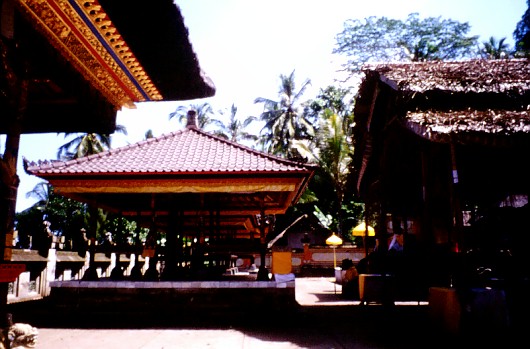 Almost all of the structures in the temple complex are open bales
- raised platforms, open on all sides, with a thatched roof for shade and
shelter from rain. Typically the ceremonies might take place in one of these
bales, or the gamelan orchestra might play here.
Almost all of the structures in the temple complex are open bales
- raised platforms, open on all sides, with a thatched roof for shade and
shelter from rain. Typically the ceremonies might take place in one of these
bales, or the gamelan orchestra might play here.
|
||||||||||||||||||||||||||||||||||||||||||||||||||||||||||||||||||||||||||||||||||||||||||||||||||||||||||||||||||||||||||||||||||||||||||||||||||||||||||||||||||||||||||||||||||||||||||||||||||||||||||||||||||||||||||||||||||||||||||||||||||||||||||||||||||||||||||||||||||||||||||||||||||||||||||||||||||||||||||||||||||||||||||||||||||||||||||||||||||||||||||||||||||||||||||||||||||||||||||||||||||||||||
|
|
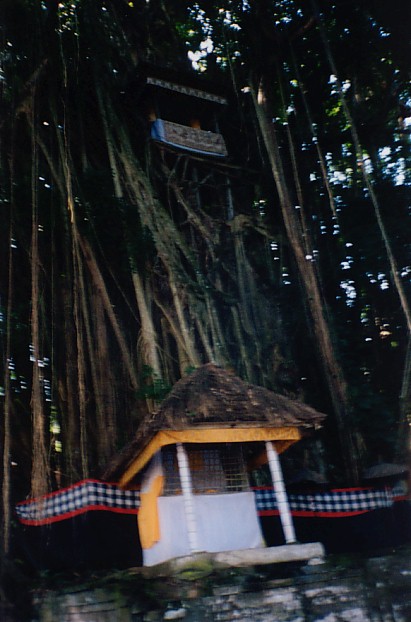 One of the most interesting features of Pura Kehen is its kul-kul
- a hollowed-out tree-trunk drum (split gong) which is suspended high up
in this ancient and sacred banjan tree, and which, like a church bell in
the West, is used to summon the faithful to prayer, and to announce special
occasions.
One of the most interesting features of Pura Kehen is its kul-kul
- a hollowed-out tree-trunk drum (split gong) which is suspended high up
in this ancient and sacred banjan tree, and which, like a church bell in
the West, is used to summon the faithful to prayer, and to announce special
occasions.
|
||||||||||||||||||||||||||||||||||||||||||||||||||||||||||||||||||||||||||||||||||||||||||||||||||||||||||||||||||||||||||||||||||||||||||||||||||||||||||||||||||||||||||||||||||||||||||||||||||||||||||||||||||||||||||||||||||||||||||||||||||||||||||||||||||||||||||||||||||||||||||||||||||||||||||||||||||||||||||||||||||||||||||||||||||||||||||||||||||||||||||||||||||||||||||||||||||||||||||||||||||||||||
|
|
|
||||||||||||||||||||||||||||||||||||||||||||||||||||||||||||||||||||||||||||||||||||||||||||||||||||||||||||||||||||||||||||||||||||||||||||||||||||||||||||||||||||||||||||||||||||||||||||||||||||||||||||||||||||||||||||||||||||||||||||||||||||||||||||||||||||||||||||||||||||||||||||||||||||||||||||||||||||||||||||||||||||||||||||||||||||||||||||||||||||||||||||||||||||||||||||||||||||||||||||||||||||||||